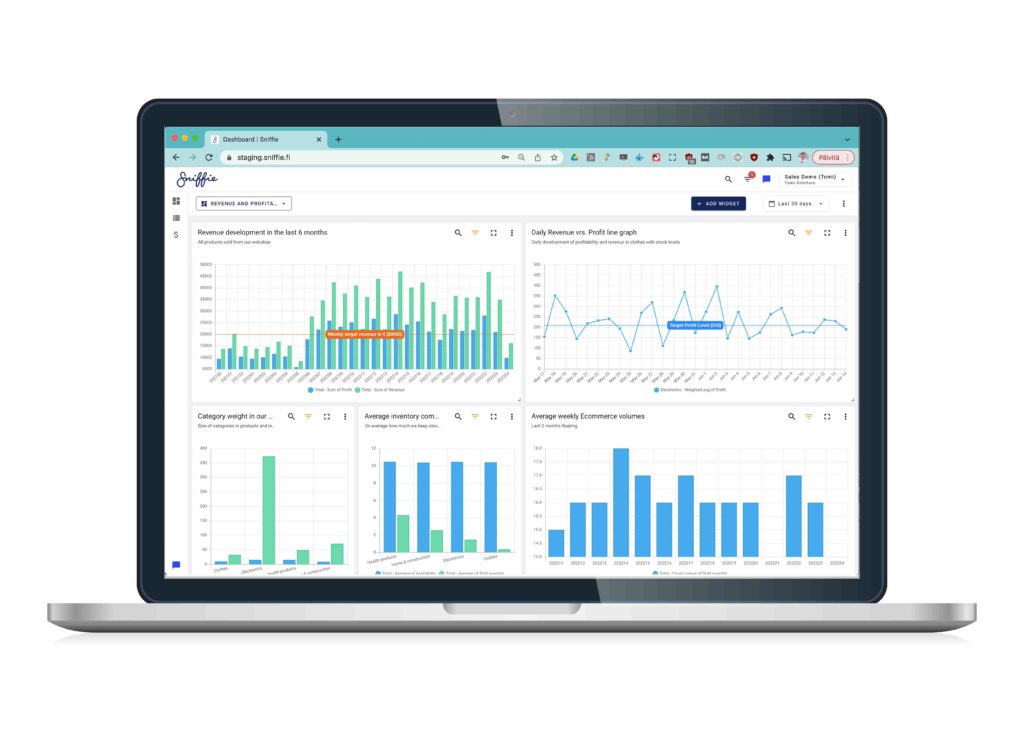Intro
Every year, there is a new big thing in ecommerce and this year, pricing is the new trend. This is not some wild theory, it’s the current state of the market.
According to this study, Google Shopping ads now account for 76.4% of retail search ad spend in the US and the UK.
Since product pricing is key to success on Google Shopping, pricing processes are currently at the core of retail success, especially when selling online. While consumers do compare prices when buying online and in physical stores, comparing prices online is much easier.
So, being able to slip by with a sub-optimal price and hoping that people won’t notice is just not an option now. This is how ecommerce works now and if you want to succeed, market-based pricing should be at the very top of your priorities.
Driving forces that make active e-commerce pricing more important than ever
a. The rise of mobile shopping
A few years ago, personal computers were the favorite choice for browsing the internet. People relied on their computers to do everything from online banking to shopping. With mobile phones getting faster and better, things have changed.
For most people, their smartphones have become the devices of choice for everything online. And that’s not some niche stat. This applies to every market you can think of. Just open your Google Analytics account and compare the percentage of people browsing your website from a smartphone, to the number of visitors using a computer.
b. Super-fast shipping is becoming the norm
Since Amazon is such a dominating force in the ecommerce world, shipping has been the weapon of choice for many online retailers. If our competitors are selling the same product for the same price, we’ll outperform them by shipping it faster, and cheaper.
At first, free shipping was a jaw-dropping deal that wowed people. Now, it’s something that many consumers expect by default. So, the focus has shifted to shipping speed. It started with next-day delivery, and now, as people are getting used to fast and cheap —even free— shipping, you’ll need to figure out a way to keep up.
c. BIG ecommerce companies are fueling the competition
It goes without saying that ecommerce giants like Amazon have lots of resources. And those big ecommerce players are using these resources to fuel the price competition.
Nowadays, all it takes is a few clicks for consumers to be able to get a full price comparison of literally every product similar to what they’re looking for.
This includes results from the local store to giants like Amazon and eBay. As an ecommerce business, you need to understand that getting your pricing right is no longer an advantage, it’s necessary if you want to stay competitive.
d. Retailer loyalty not dependent on geographical location
In a world where geographic location doesn’t really matter as much as it used to, ecommerce is becoming an extremely competitive field. Back in the day, the “local market” concept was a reality that controlled the type of competition a business would face.
While local stores competed with other stores in their neighborhood 15 years ago, the competition is now global. With the rise of ecommerce giants like Amazon —with 13 country-specific sites— that can ship to virtually any location in the world, customers have more options than ever. And as a result, there are more and more businesses competing for the loyalty of your customers, even if they’re not physically located near them.
e. Ad-block growth & privacy
The bigger the role the internet plays in our lives, the more concerned people become about privacy. What was once a free-for-all user data fest is becoming more and more regulated, and consumers care about their online privacy now more than ever.
For example, the use of ad blockers is at a staggering 42% in Greece. Regulations like the GDPR (General Data Protection Regulation) are also pushing in the same direction, and increasing customer awareness concerning privacy-related issues.
The more restrictions applied to ads, the more expensive —and ineffective— they become, and the more pricing becomes important for remaining competitive. In many cases, attractive pricing is your only way for winning new customers.
Increase your profit margins & sales with our Pricing Tool
Take the first step and see how we might be able to help you with a pricing automation solution. We offer a 7-day free trial with demo data.
No credit card needed – no strings attached.
Modal Box Title

Top pricing trends of this year
1. Transparency in pricing
In a world where people can look up prices with a quick Google search on their smartphones, transparency is the way to go when it comes to pricing. The use of mobile phones is on the rise, and that’s not some ecommerce fad that’ll soon be gone. Mobile phones are here to stay.
By 2022, ecommerce sales made from a smartphone are expected to more than double. This means that comparing prices is becoming available to everyone, anywhere. As a result, price transparency is crucial for winning the trust and loyalty of your customers. In the ecommerce world, customers have many options to choose from.
Your competitors are closer to your clients than you think, and being on their phones allows people to compare prices even easier. Remember that.
2. Importance of price in marketing
As Google Shopping becomes a more dominant force in the ecommerce world, the importance of price in marketing will keep increasing. And a generic price feed won’t cut it either. To enable the prices on Google Shopping to change fast enough for your business to remain competitive, you’ll need to use Content API.
By doing so, you’ll get 6-8 hours faster price changes in Google, which is something that you need to keep up with the fast-changing prices and market dynamics. In addition to being good to your overall online competitiveness, customers appreciate quick price updates. This will also reflect on your overall customer satisfaction rates.
Another factor that makes pricing even more important now than ever for ecommerce is SEO. People are searching for products all the time. Having an outdated, non-competitive price show up in their results is something that can lose you sales, and even customers.
3. Market-based pricing dynamics
Every business has those competitors who can directly influence their prices. There is always that competitor that people compare to you when they are about to make their purchase decision. If you’re an ecommerce business owner, you’re probably thinking about a particular competitor as you read this.
In a world where people needed to walk to different stores to compare prices, market-based pricing was important, but not critical. Nowadays, as people can compare your products to similar ones in 5 different stores without getting off their couch, it’s simply a must.
In a nutshell, market-based pricing means setting prices that are aligned with your competitors.
And unlike what many people think, this doesn’t always mean lowering your prices. The goal with market-based pricing is to get to a price range that can keep up with your competitors’, without being too low that you’re leaving money on the table, or hurting your brand image by making your products look “cheap”.
4. Rapid price testing
Testing is the best way to validate anything, and prices are no exception. While price testing is something that could take weeks —or even months— in traditional retail, it’s much easier to accomplish with ecommerce.
There is a wide array of tools that you can use to set up and analyze different price tests, that’ll give you all sorts of valuable information. This includes everything from the most profitable price points, to your overall price elasticity.
Doing these tests on a regular basis will help you maximize profitability, and ensure your prices remain competitive in the eyes of your customers. And since all these tests are digital, you have an unprecedented level of control and segmentation that allows you to get super-accurate results.
5. Growth of automation
Automation is a great idea for lots of business processes. It allows businesses to eliminate redundant tasks, and get the best results without wasting valuable human resources on it. This has been true for a long time now, and it includes everything from payrolls to pricing.
So, what has really changed in recent years that’s causing automation to increase? It’s how easy automation has become.
Even though automation was as great a few years ago as it is today, there was a barrier of entry that’s hard to overcome to most small businesses. There was a big upfront cost that businesses had to pay to automate anything, due to the technical complexity of the process. Nowadays, this is no longer the case.
Businesses can now automate different pricing processes with relevant ease, and minor upfront investment. This includes everything from getting and analyzing market data to setting pricing strategies, and monitoring the effect of these strategies. The low barrier of entry combined with the outstanding ROI of pricing automation will make it one of the fastest-growing pricing trends of the current year.
6. Pricing microsystems
Micro-services are another thing that have been getting better over the past few years. Price automation services —like Sniffie— can now easily integrate into existing, bigger services to create a new ecosystem for pricing.
Instead of having to develop their own pricing infrastructure, companies can now rely on these new integrated services to function as their own. This integration-based model saves a lot of time and money, not to mention the effort required to develop a price automation service from scratch.
Regardless of company size —or financial capabilities, pricing microservices will be a game-changer for everyone.
7. Prices are becoming harder to control
While giant online retailers were once the go-to option for large companies that wanted to sell online, this is no longer the case. Nowadays, people are more used to —and willing to accept— the concept of buying online in general, and not just through Amazon. With more than 50% of Amazon products being from third-party sellers, this is something to watch out for.
And when we say that third-party sellers are parting ways with Amazon, we mean some of the biggest companies that sell online. Nike, Ralph Lauren, and Louis Vitton are just some of those big names that are no longer selling on Amazon.
There are multiple driving forces behind this change, one of which is the fact that creating a standalone online store is now easier than ever. Small vendors —let alone large companies like Nike — can create their online store in just a few hours. This includes everything from online payments to an inventory management system.
As a result, retailers now have more freedom when it comes to pricing their products. Since they’re no longer bound to the Amazon marketplace, they’re not always competing head-to-head with other brands in the same online store.
Conclusion
There is no doubt that this year is the year of pricing. There are major forces that are reshaping the e-commerce world right now and pricing trends are part of those forces. Companies that take advantage of the pricing trends can substantially increase their revenues.
Even though there are lots of opportunities in e-commerce for companies of all sizes, there are lots of challenges as well. When you look at this year´s pricing trends, you’ll see both challenges and opportunities. For an ecommerce business with the right mindset, even these challenges can be turned into opportunities.
Learn more about e-commerce pricing
All things e-commerce pricing & price optimization right in your inbox. No spam.


